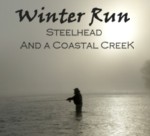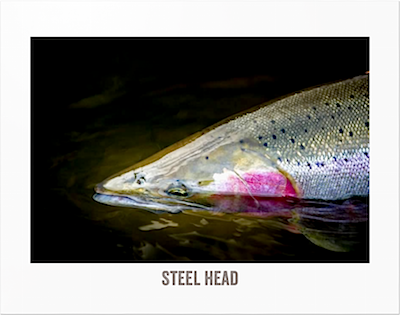Coastal Rainbow Trout
Coastal Rainbow: is a designation given to all anadromous coastal forms of rainbow trout from Baja California north to Alaska.
A Winter Run Chronicled

Read the chronicles here:
- Swimming with the Smolts
- The Expanding Marsh
- The Expanding Marsh - (continued)
- State Breach
- Uncorking the Creek in the New Year
- No Rain - No Run
- Spawn Blocker
- Where the Magic Happens
Distribution of Steelhead
Steelhead populations are strong in southeast Alaska and British Columbia but spotty along the Gulf of Alaska. Some steelhead populations have expired inland, east of the Coast Ranges and interior Columbia River basin. Current distribution may reach as far south as Santa Barbara with limited spawning manifests well into Baja, Mexico.
Two Ways of Steelheading
These are two of the ways fly-fishing for steelhead can go. Plastic beads suspended under strike indicators are the more efficient way to catch fish, if only because you can cover so much more water, but those of us who prefer it think swinging with a two-handed rod is classier, more demanding and just an all-around prettier way to fish.
That's putting it nicely. I'm told that in some circles Spey rod fishermen are seen as stuck up and pretentious and the method itself as an Old World affectation disguising the fact that we're not very good fishermen. On the other hand, I've heard the bead and bobber guys characterized as rednecks who believe in bigfoot, but not in global warming or evolution..."
John Gierach
Steelhead
Steelhead do not die after returning to spawn in freshwater and can live fairly long lives ranging from 4 to 8 years. Steelhead adapt to a variety of environmental conditions and utilize the entire river basin - from small tributary streams to deep river channels. While all O.mykiss hatch in gravel-bottomed, fast-flowing, well-oxygenated rivers and streams, some stay in fresh water all their lives. These fish are generally know as rainbow trout. The Steelhead that migrate to the ocean develop a much more pointed head, become more silvery in color, and grow larger than fresh-water rainbows.

Steelhead can live for as long as 11 years and grow as large as 55 pounds. They may spend as long as seven years in fresh water before migrating downstream to the estuaries as smolts and then into the ocean to feed and mature. Their coloring is quite distinctive: from dark olive green on their backs shading to silvery-white underneath, they sport a pink lateral band. They also tolerate a greater range of water temperatures than other salmon, which may explain their longevity.
Steelhead have two general life history patterns: winter and summer.
Winter Steelhead
Winter steelhead enter streams from the ocean when the more abundant winter rains contribute to larger in-stream flows. These larger flows widen and deepen thestream greatly aiding the steelheads' migration and access to spawning ground. The usual spawning grounds for wild strains of steelhead are located in tributaries to the mainstem river. Afer spawning, these steelhead will return downstream to the ocean.
Summer Steelhead
For the Summer steelhead, or spring-run steelhead, they enter streams as smaller, immature fish during the receding flows of spring. They gradually migrate upstream looking for deep pools to hold in near the headwater. They spend the summer in these waters while they mature - moving later to spawn in the winter or spring.

